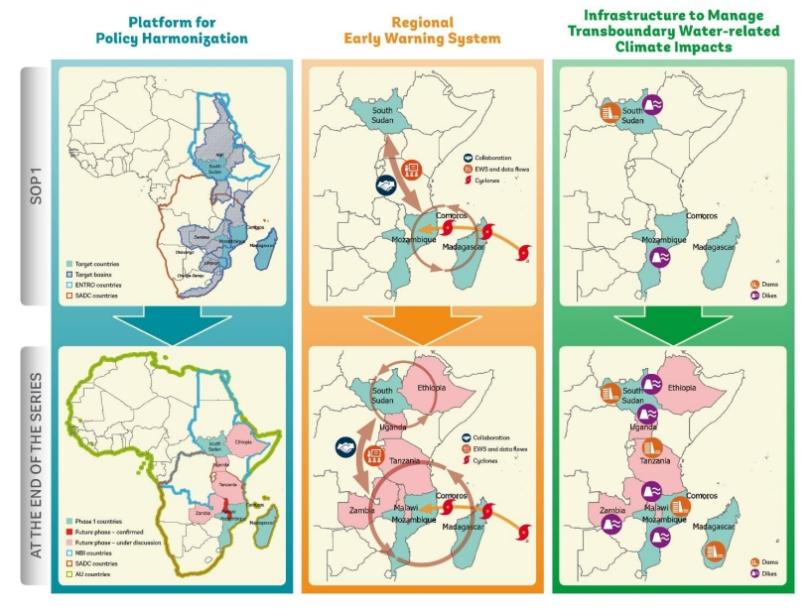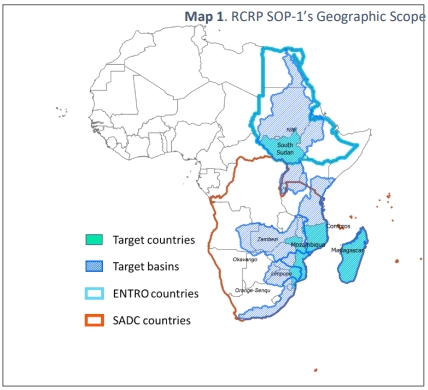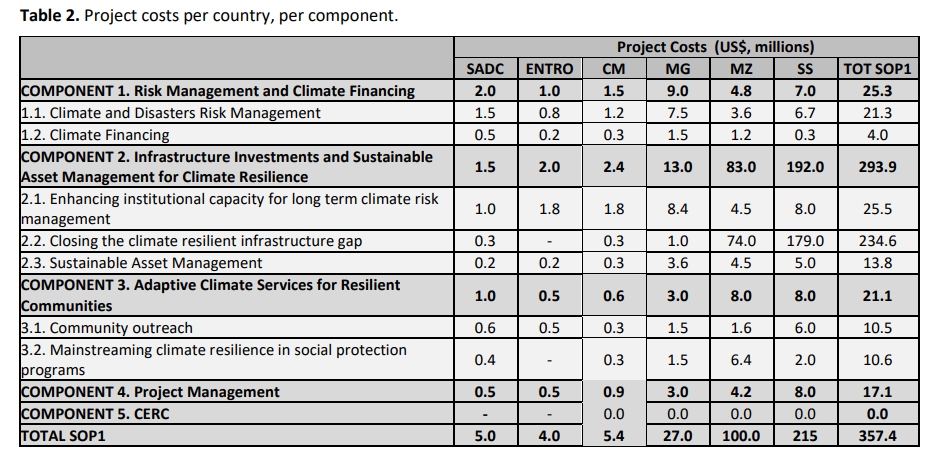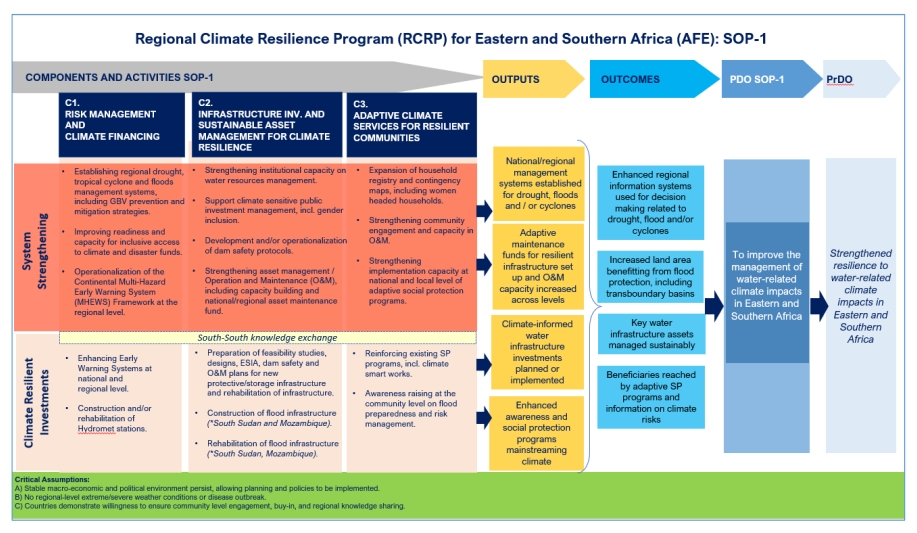
The proposed Program will be coordinated at both the national and the regional level. At the national level by national project implementation units (PIUs) under relevant Ministries/SADC and ENTRO Secretariat, strengthening already existing units, whenever possible.
A SOP is a programmatic approach allowing for tailored support to the needs of diverse countries, while supporting the achievement of a common long-term regional objective. The RCRP SOP is thus a long-term program to address the serious gaps in how participating countries are able to address the complex challenges of climate change impacts on water resources, and in turn, on AFE economies and people.

The RCRP will support countries in the AFE region to move towards a new green, inclusive, and resilient growth pathway, harnessing the powerful synergies that exist between water resources, disaster risk management and social protection, enabling the achievement of climate resilience and development goals. In its initial operation, the Program places emphasis on setting out a robust basis for future large-scale transformative investments, critical to increase the resilience of the region in this changing climate. Regional approaches to fostering more gender-responsive approaches, and to increasing the representation of women in technical and leadership positions within hydromet or water resource management institutions also offer significant advantages.
Component 1. Risk Management and Climate Financing (US$25.3 million, including US$7.1 million National IDA and US$17.2 Regional IDA, and US$1 million Crisis Response Window, CRW). The objective of this component is to build regional and national institutional capacity and strengthen cooperation on climate and disasters risk management and climate financing.
Component 2. Infrastructure Investments and Sustainable Asset Management for Climate Resilience (US$293.9 million, including US$57 million National IDA, US$114.9 million Regional IDA, US$102 million CRW, and US$20 million Window for Host Communities and Refugees, WHR). Improving management of water-related climate impacts in AFE requires closing the regional gap on critical water infrastructure for climate resilience, as well as a strong institutional framework (i.e., rules and organizations) for mainstreaming climate considerations as part of the planning, implementation, and operation of the new infrastructure. Given the tight fiscal space in participating countries, it is crucial to extend the lifeline and effectiveness of existing protective and storage infrastructure via improved asset management, and in particular, improved maintenance. For both climate resilience planning and O&M, it is critical to focus on a whole-of-government approach17, that moves beyond a single sector but instead looks at the whole financial flows and competing demands. This will be achieved through (i) institutional development and planning; (ii) infrastructure development and rehabilitation; and (iii) sustainable asset management. Taking a regional approach under this component is fundamental as the region has much to offer in terms of lessons learnt, shared challenges, and successful solutions – the regional perspective thus helps maximize economies of scale and make the best use of scarce resources for larger impact.
Component 3. Adaptive Climate Services for Resilient Communities (US$21.1 million, including US$3.2 million National IDA, US$7.9 million Regional IDA, US$6 million CRW, and US$4 million WHR). Strengthening social and human capital resilience to climate change in AFE will include enhancing last mile community preparedness and mainstreaming the climate dimension in social protection policy design, operational and budgetary planning, including in cash for work programs, whilst integrating gender needs. Adaptive social protection programs play a key role in the climate change risks cycle, from information campaigns about climate risks to vulnerability reduction to shock response. The development of these programs would decrease the number of refugees and displaced in case of disaster, thus preventing negative spillovers across countries, whilst safeguarding livelihoods of people in exposed areas.
Component 4. Project Management. (US$17.1 million, including US$4.7 million National IDA, US$10.4 million Regional IDA, US$1 million CRW, and US$1 million WHR). This component will finance all project management activities in participating countries and regional organizations, including equipment and materials, technical assistance and compliance with fiduciary, procurement, and safeguards (environmental and social) requirements, security planning and management, remote supervision, monitoring and evaluation (M&E) and impact assessment, knowledge management and communication, and when needed, support to technical activities and supervision. It will also finance national grievance redress mechanisms (GRM) and other project operating costs. At the national and regional organizations’ level, the activities will be performed by Project Implementation Units (PIUs), established under relevant Ministries, maximizing wherever possible complementarity with existing PIUs. A Regional Steering Committee (RSC) will be established to increase coordination across the region. This component will finance participation at regional events and knowledge sharing, including in the meetings of the RSC.
Component 5: Contingent Emergency Response (US$0). A Contingent Emergency Response Component (CERC) is included in the project, under South Sudan’s, Madagascar’s, and Comoros’ and Mozambique’s financing agreements. 18 This will allow for rapid reallocation of uncommitted funds under corresponding credits and grants in the event of an eligible crisis or emergency. Under this Project, eligible emergencies would be limited to the following: (i) floods/cyclones causing destruction, contamination, and limiting access to water services; (ii) droughts affecting water supplies for human consumption and livestock; (iii) localized water-borne disease epidemics related to flood/cyclones, and drought emergencies, and (iv) conflict-related impacts to water infrastructure. For the CERC to be activated and financing to be provided: (a) the Recipient’s relevant authority has to declare a disaster, emergency or catastrophic event; (b) the Association and the Recipient have to agree in writing to address such disaster, emergency or catastrophic event under the Project and in accordance with the provisions of the respective Financing Agreement; (c) the Recipient has to ensure that all environmental and social management instruments required for said activities have been prepared and disclosed, and the Recipient has to ensure that any actions which are required to be taken under said instruments have been implemented, all in accordance with the applicable provisions of the respective CERC Manual; (d) the Coordinating Agency in charge of coordinating and implementing the CERC must have adequate staff and resources, for the purposes of said activities; and (e) the Recipient has to adopt a CERC Manual.

The Program’s primary target groups are (a) selected national, sub-national and regional entities that will increase their capacity; and (b) vulnerable communities in selected areas of participating countries: a) Regional Institutions. SADC and ENTRO’s capacity will be enhanced through their participation in tailored technical trainings (e.g., access to climate financing) and South-South exchange on priority topics that contribute to the achievement of their regional mandates, as well as through the enhancement of their role as regional convenors and promoters of dialogue and cooperation around regional EW systems, data sharing, transboundary waters, and NR management. b) National Institutions. Program beneficiaries include institutions responsible for hydromet and early warning systems, disaster risk management, and water resources management at the regional, national and subnational levels, including line Ministries, government agencies, national authorities, and agencies at the national and subnational levels. c)Community-Level. Vulnerable communities and families will directly benefit from improved early warning systems and preparedness capacity, and will also indirectly benefit from the flood risk management works, community outreach, and inclusion in social registries and possible participation in water related public works. In South Sudan, the project’s beneficiaries will include refugees and host communities in flood hotspots.

